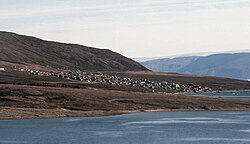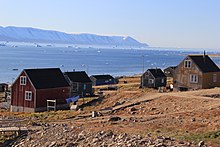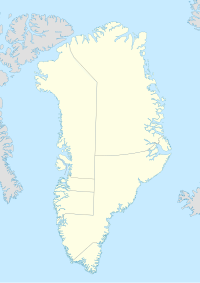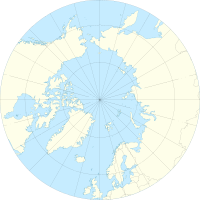Qaanaaq
Qaanaaq
Thule | |
|---|---|
 Qaanaaq | |
| Coordinates: 77°28′00″N 69°13′50″W / 77.46667°N 69.23056°W | |
| Sovereign state | |
| Autonomous country | |
| Municipality | Avannaata |
| First settled | 2000 BC |
| Population (2020) | |
| • Total | 646[1] |
| Time zone | UTC-04[2] or UTC-03[3] |
| • Summer (DST) | UTC-03[2] or UTC-02 |
| Postal code | 012345 |
Qaanaaq (Greenlandic pronunciation: [qaːnɑːq]), formerly known as Thule or New Thule, is the main town in the northern part of the Avannaata municipality in northwestern Greenland. It is one of the northernmost towns in the world. The inhabitants of Qaanaaq speak the local Inuktun language and many also speak Kalaallisut and Danish. The town has a population of 646 as of 2020.[1] The population was forcibly relocated from its former, traditional home, which was expropriated for the construction of a United States Air Force base in 1953.
Geography
Qaanaaq is located in the northern entrance of the Inglefield Fjord. The village of Qeqertat is located in the Harvard Islands, near the head of the fjord.[4]
History

The Qaanaaq area in northern Greenland was first settled around 2000 BCE by Paleo-Eskimos migrating from the Canadian Arctic.[5] These people were displaced by the Thule culture which followed the same migration route around 1100 CE. By 1600, climatic effects of the Little Ice Age caused the semi-nomadic Thule culture in Greenland to fragment into isolated groups, with inhabitants of the northwest diverging as the Inughuit. As they lost access to open water due to thickening sea ice, they lost the ability to build boats and had limited hunting opportunities.[6]
In 1818, Sir John Ross's expedition made first contact with nomadic Inuktun (Polar Eskimos) in the area. James Saunders's expedition aboard HMS North Star was marooned in North Star Bay 1849–50 and named landmarks.[7] Robert Peary built a support station by a protected harbor at the foot of iconic Mount Dundas in 1892. It served as a base camp for his expeditions and attracted a permanent population. In 1910 explorers Knud Rasmussen and Peter Freuchen established a missionary and trading post there. They called the site "Thule" after classical ultima Thule; the Inuit called it Umanaq ("heart-shaped"), and the site is commonly called "Dundas" today. The United States abandoned its territorial claims in the area in 1917 in connection with the purchase of the Virgin Islands. Denmark assumed control of the village in 1937.
A cluster of huts known as Pituffik ("the place the dogs are tied") stood on the wide plain where the base was built in 1951. (A main base street was named Pituffik Boulevard.) The affected locals moved to Thule. However, in 1953 the USAF planned to construct an air defense site near that village, and in order to prevent contact with soldiers in a way deemed "unhealthy", the Danish government forcibly relocated "Old Thule" with about 130 inhabitants to a newly constructed, modern village 60 miles (97 km) north, known as Qaanaaq, or "New Thule". In a Danish Supreme Court judgment of 28 November 2003 the move was considered an expropriative intervention. During the proceedings it was recognized by the Danish government that the movement was a serious interference and an unlawful act against the local population. The Thule tribe was awarded damages of 500,000 kroner, and the individual members of the tribe who had been exposed to the transfer were granted compensation of 15,000 or 25,000 each. A Danish radio station continued to operate at Dundas, and the abandoned houses remained. The USAF only used that site for about a decade, and it has since returned to civilian use.
Knud Rasmussen was the first to recognize the Pituffik plain as ideal for an airport. USAAF Colonel Bernt Balchen, who built Sondrestrom Air Base, knew Rasmussen and his idea. Balchen led a flight of two Consolidated PBY Catalina flying boats to Thule on 24 August 1942 and then sent a report advocating an air base to USAAF chief Henry "Hap" Arnold. However, the 1951 air base site is a few miles inland from the original 1946 airstrip and across the bay from the historical Thule settlement, to which it is connected by an ice road. The joint Danish-American defense area, designated by treaty, also occupies considerable inland territory in addition to the air base itself.[8]
The town of Qaanaaq was established in the winter of 1953 when the United States expanded Pituffik Space Base and forcibly relocated the population of Pituffik and Dundas 31 km (19 mi) to the north within four days. The settlement was subsequently moved another 100 km (62 mi) to the north.
A 48.6-kilogram (107-pound) fragment of the Cape York meteorite, discovered near Thule in the summer of 1955, is named for the town.
Culture

Ways of living so far north and in such severe climatic conditions are passed on from generation to generation, and this ability to adapt has contributed to the survival of this small settlement. When the sea becomes open sometime around August, large dinghies with powerful engines are used for both hunting trips and ordinary journeys. There is still sunlight twenty-four hours a day at this time—the midnight sun lasts from the middle of April to the end of August. Scarcity of resources requires they use every part of a harvested animal: the skins are used for clothing and covering the kayaks; the flesh and offal are eaten by humans and domestic animals; the narwhal and walrus tusks are carved into finely-worked figures, jewellery and hunting implements; and feathers can be used in handicrafts.[citation needed]
Education
The local school, Avanersuup Atuarfia, has around 120 pupils in forms 1 to 10. There is also a boarding school which holds about 20 students from surrounding settlements. The town kindergarten has a capacity of 34 children while the day nursery can hold up to 12.[9]
Transport
Air Greenland operates fixed-wing aircraft services between Qaanaaq Airport and Upernavik Airport, with further connections to Ilulissat Airport and Qaarsut Airport. Settlement flights operate to Siorapaluk, sporadically to Moriusaq, and to Savissivik via Pituffik Space Base.[10]
There are a few unpaved dirt roads in Qaanaaq. Only one road leaves the town - it connects to Qaanaaq Airport. Pickup trucks and SUVs are found in Qaanaaq, but skis, dogsleds and walking are better alternatives for getting around.[11]
Medical and emergency services
There is a small hospital (built in the 1950s and rebuilt in 1996) in Qaanaaq with basic health care offered. More advanced care requires transfer to other medical centers in Greenland by air.[12] Dental care is offered in the form of a dentist who visits the town twice a year.[13] Qaanaaq Hospital falls under the Avannaa health region.
A small local fire brigade is assisted by firefighters from the Pituffik Space Base.

Government
The town is part of the region of Avannaata, which is represented by a 17-member council and mayor.
CTBTO Station
Qaanaaq is home to a remote CTBTO infrasound listening station called IS-18, which uses an array of barometric sensors to detect possible nuclear tests around the world.[13][14] The station is maintained by the Danish Meteorological Institute, and as of 2016 the current operator is Svend Erik Ascanius.[13]
Population
With 646 inhabitants as of 2020, Qaanaaq is the largest settlement in the far north of the country.[1] Its population has been relatively stable with only minor fluctuations since the mid-1990s.[15]
The city, with its relatively low population and tradition of hunting, currently has more huskies than human residents.[13]
Climate
Qaanaaq has a cold tundra climate (Köppen climate classification ET), and hence it has long, cold winters. July and August are the warmest months, and peak high temperatures rarely exceeding 20 °C (68 °F) occur in June and July.
| Climate data for Qaanaaq (1995-2020) | |||||||||||||
|---|---|---|---|---|---|---|---|---|---|---|---|---|---|
| Month | Jan | Feb | Mar | Apr | May | Jun | Jul | Aug | Sep | Oct | Nov | Dec | Year |
| Record high °C (°F) | 5.9 (42.6) |
4.1 (39.4) |
9.8 (49.6) |
6.0 (42.8) |
14.0 (57.2) |
20.9 (69.6) |
20.3 (68.5) |
17.6 (63.7) |
13.3 (55.9) |
12.5 (54.5) |
9.0 (48.2) |
8.3 (46.9) |
20.9 (69.6) |
| Mean daily maximum °C (°F) | −18.1 (−0.6) |
−19.1 (−2.4) |
−16.9 (1.6) |
−8.3 (17.1) |
0.5 (32.9) |
6.4 (43.5) |
10.0 (50.0) |
8.4 (47.1) |
2.4 (36.3) |
−4.2 (24.4) |
−9.8 (14.4) |
−14.6 (5.7) |
−5.3 (22.5) |
| Daily mean °C (°F) | −21.7 (−7.1) |
−23.0 (−9.4) |
−21.7 (−7.1) |
−13.8 (7.2) |
−3.7 (25.3) |
3.0 (37.4) |
6.6 (43.9) |
5.5 (41.9) |
−0.4 (31.3) |
−6.7 (19.9) |
−12.6 (9.3) |
−17.8 (0.0) |
−8.9 (16.1) |
| Mean daily minimum °C (°F) | −25.2 (−13.4) |
−26.8 (−16.2) |
−26.3 (−15.3) |
−19.3 (−2.7) |
−8.5 (16.7) |
−0.1 (31.8) |
3.4 (38.1) |
2.9 (37.2) |
−2.8 (27.0) |
−9.1 (15.6) |
−15.5 (4.1) |
−21.1 (−6.0) |
−12.4 (9.7) |
| Record low °C (°F) | −40.5 (−40.9) |
−40.0 (−40.0) |
−41.2 (−42.2) |
−33.0 (−27.4) |
−23.1 (−9.6) |
−6.4 (20.5) |
−3.0 (26.6) |
−6.7 (19.9) |
−15.4 (4.3) |
−29.8 (−21.6) |
−32.5 (−26.5) |
−36.9 (−34.4) |
−41.2 (−42.2) |
| Average precipitation mm (inches) | 6 (0.2) |
6 (0.2) |
4 (0.2) |
6 (0.2) |
7 (0.3) |
7 (0.3) |
16 (0.6) |
24 (0.9) |
18 (0.7) |
12 (0.5) |
10 (0.4) |
8 (0.3) |
124 (4.9) |
| Average precipitation days (≥ 1.0 mm) | 2 | 2 | 1 | 2 | 2 | 2 | 4 | 4 | 4 | 3 | 3 | 2 | 31 |
| Average relative humidity (%) | 64.1 | 66.5 | 64.9 | 64.8 | 70.1 | 76.5 | 76.1 | 73.6 | 63.2 | 62.6 | 61.7 | 64.3 | 67.4 |
| Mean monthly sunshine hours | 0 | 8 | 150 | 251 | 316 | 273 | 271 | 175 | 155 | 49 | 0 | 0 | 1,648 |
| Source 1: NOAA (precipitation, precipitation days and sunshine 1961-1990)[16][17] | |||||||||||||
| Source 2: Danish Meteorological Institute (temperatures and humidity 1995-2020)[18][19] | |||||||||||||
References
- ^ a b c Population in Localities January 1st by place of birth, gender, locality and time. Statistics Greenland. ISBN 978-87-986787-7-9. ISSN 1602-5709. Retrieved 6 September 2013.
- ^ a b "Greenland Time Zone - Greenland Current Local Time". www.timetemperature.com.
- ^ "We make Greenland accessible". www.airgreenland.com.
- ^ "Qaanaaq". Mapcarta. Retrieved 27 March 2019.
- ^ Fortescue, Michael. Language Relations Across Bering Strait: Reappraising the Archaeological and Linguistic Evidence. Open Linguistic Press, Cassell, 1998. ISBN 0-304-70330-3
- ^ Dick, Lyle (2001). Muskox Land: Ellesmere Island in the Age of Contact. University of Calgary Press. pp. 11, 29. ISBN 978-1-55238-050-5.
- ^ "Icy Imprisonment: The 1849 Voyage of the HMS North Star". 3 September 2014.
- ^ Gilberg, Rolf. "Thule" (PDF). Retrieved 13 July 2012.
- ^ Administrator, Odeum. "Qaanaaq". qaasuitsup-kp.cowi.webhouse.dk. Retrieved 13 September 2018.
- ^ "Booking system". Air Greenland. Archived from the original on 22 April 2010. Retrieved 9 June 2010.
- ^ Practical info - The Official Tourism Site of Greenland
- ^ "Qaanaaq, Greenland". Archived from the original on 8 March 2016. Retrieved 21 January 2013.
- ^ a b c d "IS18, Qaanaaq, Greenland, Denmark: CTBTO Preparatory Commission". www.ctbto.org. Retrieved 19 September 2016.
- ^ Scott, Tom (12 September 2016). "Listening for Nuclear Tests at the Top of the World". YouTube. Archived from the original on 12 December 2021. Retrieved 20 September 2016.
- ^ a b Statistics Greenland, Population in localities
- ^ "Thule Air Base Climate Normals 1961-1990". National Oceanic and Atmospheric Administration. Retrieved 14 February 2013.
- ^ "Thule Climate Normals 1961-1990". National Oceanic and Atmospheric Administration. Retrieved 14 February 2013.
- ^ "Climatological Standard Normals 1991-2020 - Greenland" (PDF). www.dmi.dk. Retrieved 14 March 2023.
- ^ "04205: Mittarfik Qaanaaq (Greenland)". ogimet.com. OGIMET. 20 December 2021. Retrieved 21 December 2021.
Further reading
- Murray, Louise. 2006. "On Thin Ice – Louise Murray Travels to Qaanaaq in Northern Greenland to See the Effect That Climate Change Is Having on Subsistence Hunters and Their Prey". Geographical : the Royal Geographical Society Magazine. 32.
- Remie, C. H. W. Facing the Future Inughuit Youth of Qaanaaq : Report of the 1998 University of Nijmegen Student Expedition to Qaanaaq, Thule District, Northern Greenland. Nijmegen: Nijmegen University Press, 1999. ISBN 90-5710-078-9




